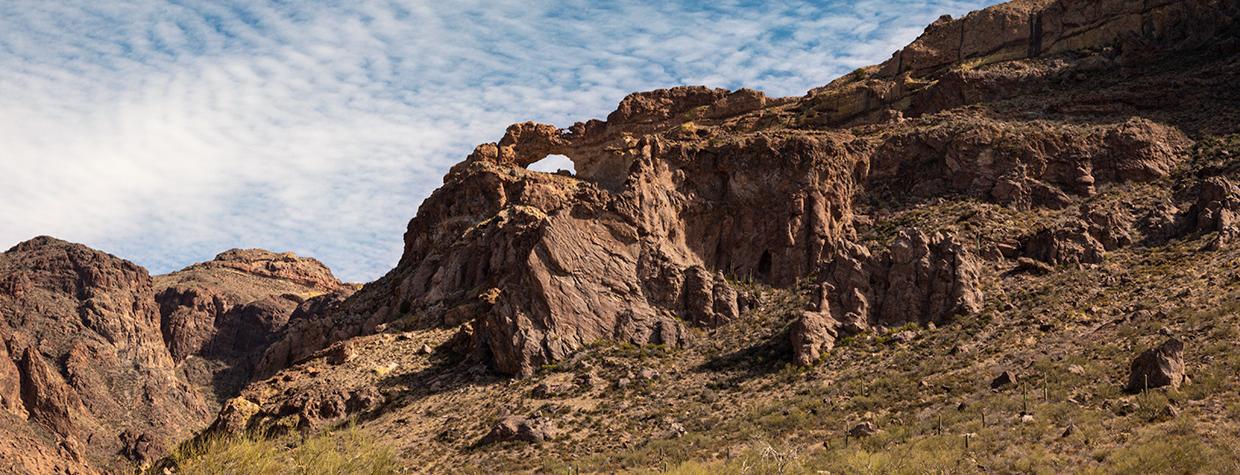Organ Pipe Cactus National Monument covers 516 square miles of Southern Arizona, so you could spend a month there and not see all of this isolated, biodiverse jewel of the national park system. But most people spend significantly less than a month there — and Ajo Mountain Drive is for them. Careful drivers can navigate this 20-mile loop in most vehicles, and it traverses much of what makes Organ Pipe great, including unique desert flora, steep mountains and dramatic views.
Before you embark, stop at the monument’s visitors center to pay your entrance fee and pick up a guide to the route; numbered stakes along the road correspond to entries in the guide. Then, head east on Ajo Mountain Drive, which is across State Route 85 from the visitors center. In the early going, you’ll see plenty of Sonoran Desert staples such as saguaros, chollas and ocotillos along this wide, washboarded dirt road. Straight ahead, to the east, are the craggy peaks of the Ajo Range, which is topped by 4,819-foot Mount Ajo. You’ll get a closer look at the mountains later, but for now, enjoy the view along the road — which splits and becomes a narrower, one-way route at Mile 2.
Two miles past the split, you’ll spot your first organ pipe cactus (Stenocereus thurberi), and a mile later, these aptly named, many-limbed columnar cactuses line both sides of the road. The monument harbors most of the U.S. population of this species — which, like the saguaro, tends to grow on south-facing slopes. While there are 30 other cactus species at the monument, the organ pipes are among the most visible and dramatic, and you can enjoy them over lunch at the shaded Diablo Canyon Picnic Area, just ahead.
Past the picnic area, a paved section of road, one of several on this drive, winds into the foothills of the Ajo Range, offering lovely panoramas around every corner. Healthy organ pipes proliferate on seemingly every hillside — on average, these cactuses’ stems grow about 2.5 inches per year. Also keep an eye out for a natural arch high above the road; from the Arch Canyon Trailhead, at Mile 9, you can hike a short, easy trail that offers good views of the rock formation. (An unmaintained and much steeper extension of that trail will take you all the way up to the arch, but it isn’t for the faint of heart.)
The road then curves to the south and around the mountains, providing nice views of the steep cliffs on the left. Past the Estes Canyon-Bull Pasture Trailhead, which leads to another lovely hike, you’ll pass through a forest of healthy organ pipes and tall saguaros. Around Mile 13, the organ pipes fade away as the road rolls into a flatter area that isn’t as ideal for those cactuses, and numerous chollas, ocotillos and prickly pears take their place. But the monument’s crown jewels return a few miles later, offering one more look at a plant you aren’t likely to see elsewhere.
Eighteen miles in, you’ll return to the two-way road you took at the start of the drive. Turn left and retrace your route for 2 miles back to SR 85, where you can think about which of Organ Pipe’s 516 square miles you’ll explore the next time you visit.
Note: Mileages are approximate.
Length: 20-mile loop (from State Route 85)
DIrections: From Ajo, go south on State Route 85 for 33 miles to Ajo Mountain Drive. Turn left (east) onto
Ajo Mountain Drive and continue 20 miles around the loop and back to SR 85.
Vehicle requirements: A high-clearance, four-wheel-drive vehicle, such as an SUV or truck, is recommended, but the route is passable in a standard sedan in good weather.
Special consideration: National Park Service fees apply. Additionally, while the monument is safe to visit, crossings and other illegal activities do occur along the U.S.-Mexico border. Stay on maintained park roads, do not pick up hitchhikers, and report any suspicious behavior or distressed people you encounter to the monument’s staff or the Border Patrol.
Warning: Back-road travel can be hazardous, so be aware of weather and road conditions. Carry plenty of water. Don’t travel alone, and let someone know where you are going and when you plan to return.
Information: Organ Pipe Cactus National Monument, 520-387-6849 or nps.gov/orpi
Travelers in Arizona can visit az511.gov or dial 511 to get information on road closures, construction, delays, weather and more.

